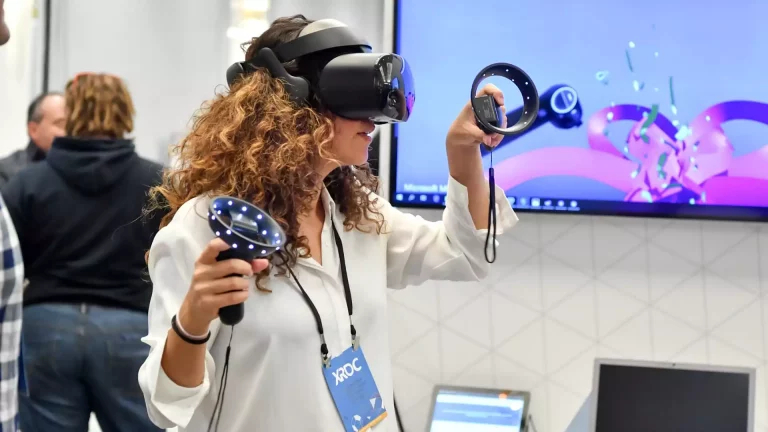
OpenAI’s generative AI tool, ChatGPT, has garnered strong reactions from practically everyone who encounters it. While professors grapple with students using it to write essays, many business leaders have embraced the technology with open arms, using it to perform administrative tasks and maximize efficiency.
A separate technology gaining steam is VR training. This is when VR is used for immersive demonstrations of a given workplace process or protocol. It’s known to boost memory recall due to its highly immersive UX. It also can lead to organizational efficiencies and cost savings by training far-flung individuals at scale without travel costs.
So how do these technologies – conversational AI and VR training – converge? Let’s explore a few ways…
1. Improving Accessibility
According to the World Health Organization, around 16% of people have a significant disability. Disabilities can make it hard to participate in traditional classroom-based training.
VR training shines in scenarios where multiple people need to be trained simultaneously. People in the back of the room may struggle to see a TV screen or hear an instructor speak, but with a VR headset, everyone can easily see and hear what’s going on.
ChatGPT can create content accessible to all trainees regardless of their abilities. For example, if a person has a significant hearing impairment, ChatGPT can write captions or subtitles to accompany their VR training session.
2. Generating Realistic Scenarios
One of VR’s biggest advantages is that it allows trainees to experience realistic scenarios without any physical risk. However, coming up with these scenarios can be challenging and time-consuming. ChatGPT can help by generating realistic scenarios based on certain criteria such as industry type or skill level.
For example, if you’re training construction workers, you can create a scenario where trainees have to inspect a building site for safety hazards. Police officers in training can participate in scenarios involving bystanders, suspects, and other officers. Based on how these people act in each scenario, trainees can learn how to communicate and negotiate more effectively.
3. Saving Time and Money
Creating high-quality training content can be time-consuming and costly, especially when data is disorganized or unstructured. According to the International Data Corporation, 80% of global data may be unstructured by 2025. ChatGPT can synthesize data points to generate outlines in a matter of seconds.
Although ChatGPT often delivers content that lacks the human touch and requires light editing, it still excels at creating lists, dialogue, overviews, and instructions at lightning speed, which is helpful when you’re strapped for time. It can also generate feedback messages that appear within the VR training environment, letting people know what to improve and what they’re doing well.
4. Creating Interactive Simulations
ChatGPT can generate scripts and dialogue for interactive VR training content. In these simulations, trainees can make decisions and then see the consequences of their actions in real time. For instance, if you’re training health care professionals, ChatGPT can create a simulation where trainees must make decisions about patient care and see how those decisions affect the patient’s health.
5. Adapting to Changing Needs
Training needs can change quickly, especially in ever-evolving industries like tech and health care. ChatGPT can write updated training content to reflect the changing world — at least, it does the best it can with the information it gathered before 2021.
Because programmers haven’t trained the AI on any data since then, it doesn’t always understand current events or upcoming dates. Still, ChatGPT is an excellent tool for rewriting old training modules to better reflect the modern era.
6. Customizing Training
Personalization is crucial for training. ChatGPT can tailor content to each trainee’s learning style and needs. For example, if a certain trainee needs more repetition or struggles to do a specific task, ChatGPT can generate a training module that helps them with those weak points. It can create different scripts for each trainee to use.
7. Enhancing Retention
Given the choice between reading a training manual and using a VR headset, most people would probably choose the latter. It makes for a more engaging experience. In turn, trainees are more likely to pay attention and retain the info they just learned.
ChatGPT can create memorable, interesting scenarios on just about any topic to improve retention rates. For example, it can create a script for a VR simulation of a successful — or not-so-successful — sales pitch.
A Logical Alliance
Although ChatGPT has its limitations, it excels at writing dialogue, scripts, and feedback for VR training content modules. It can help developers customize their training programs for individual people to create engaging and accessible content. VR training and ChatGPT are both still in their infancy, but as time goes on, using them together will likely become commonplace for content creators.
 April Miller is a senior writer at ReHack Magazine and editorial contributor at AR Insider. She specializes in VR/AR, IoT, and business technology. See her work here and follow her @rehackmagazine.
April Miller is a senior writer at ReHack Magazine and editorial contributor at AR Insider. She specializes in VR/AR, IoT, and business technology. See her work here and follow her @rehackmagazine.






